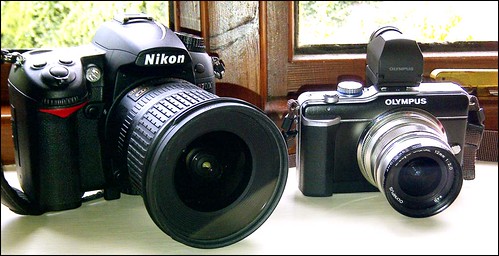I've been getting very excited by the results from the Olympus f/2 lens, and from the videos I posted earlier, so are some other people. I decided to try it out against my Nikon D7000 fitted with a Nikon 10-24mm zoom set at 16mm.
A few things to notice. Firstly, one is a 12mm and one is a 16mm. As you can see the relative distances in the background are not the same which reflects the different focal lengths. Both settings are supposed to be a 24mm full frame / 35mm equivalent. But as you can see the difference of 4mm makes quite a difference to the perspective. Secondly, the difference in sensor also makes a difference to the depth-of-field. Thirdly the colour balance of the Olympus camera (An E-PL1) is significantly warmer. In terms of accuracy, neither are correct. Fourthly the Nikon is 3:2 and the Olympus is 4:3. So though I had the same settings on the camera and shot from the same place, the images are slightly different.
However, I don't think that the above invalidates the test, which I was carrying out to see just how much my impressions are borne out by a direct comparison with what many, not myself I hasten to add, would classify as a more "serious" camera.
The files are full-size, and if you click through to flickr and select Actions > View all sizes you can see the full-resolution files, which are somewhat large.
Since I used the same settings for raw development, i.e. Photoshop Adobe Camera Raw at the default settings, neither has been influenced by adding extra sharpening or changing the colour balance.
In all the five samples, and indeed in the rest of the comparisons I shot, the Olympus with the 12mm f/2 is sharper. Whether this is down to a stronger AA flter on the Nikon or the fact that the Nikon is not such a good lens, I cannot say. The 10-24mm is not a 14-24mm f/2.8, but it is however a well-regarded lens.
I've used both Nikons and m4/3 extensively and the results do bear out exactly what I've been seeing for some time. That in terms of image quality m4/3 is right up there with the best DSLR's (Not just "entry-level" as is often suggested) and that at low ISO's it can more than hold its own, and in many cases surpass the output from larger sensors. In terms of speed, features and the ability to keep on working efficiently, the D7000 is a powerful beast and shouldn't be underestimated. Its a very nice camera to work with, and take pictures with. However, it may not have the edge over m4/3, in terms of image quality, with particular regard to sharpness, when Olympus and Panasonic cameras are fitted with top-quality lenses.
And indeed, I think that the Olympus f/2 can be regarded as a top-quality lens, and I don't think that those people like myself who who enthusing about it are either getting carried away or exaggerating.
Here are two further samples of the f/2. Both shot on the E-PL1 from raw, and both edited to show what I would do with them when I send files to picture libraries. To that end I have interpolated both files up to 50MB, which is slightly more than the native D7000 files. By comparing these with the D7000 versions of the comparison files, I will leave it to you to decide how 12MP m4/3 stands up to 16MP APS-C. Both files are full-size again on flickr.







